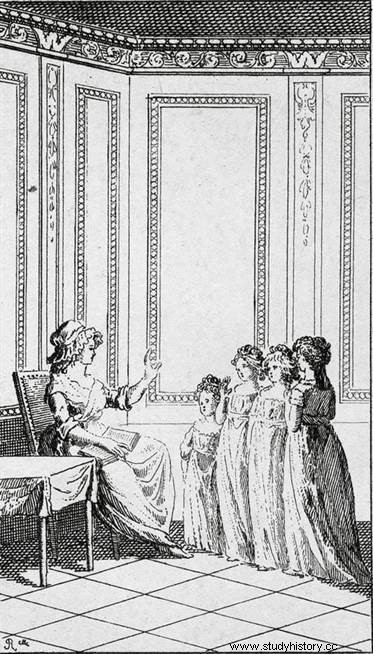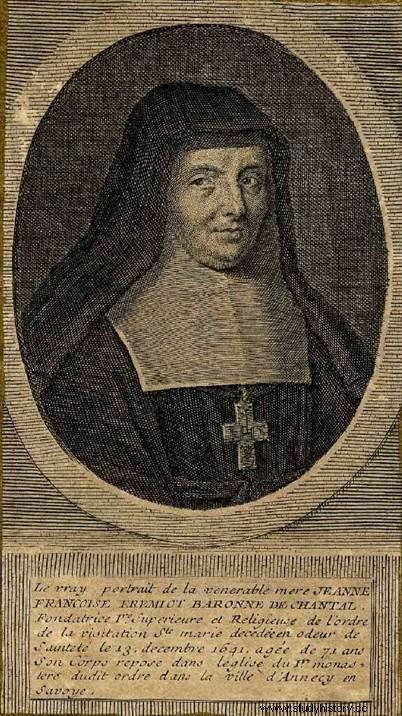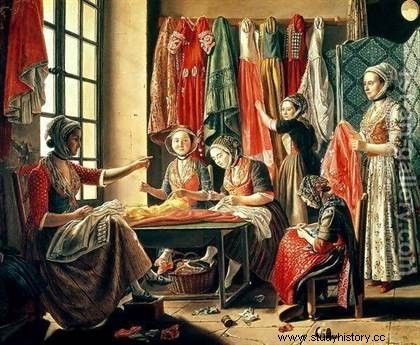 Historians have long considered that when it comes to girls' education , the royal house of education of St Cyr was both an example and a uniqueness within a society where educational priorities go to the male sex. Recent historical research on the subject has, however, demonstrated the desire to educate girls as well, but this education extends well beyond the nobility since it also affects the most disadvantaged strata of society.
Historians have long considered that when it comes to girls' education , the royal house of education of St Cyr was both an example and a uniqueness within a society where educational priorities go to the male sex. Recent historical research on the subject has, however, demonstrated the desire to educate girls as well, but this education extends well beyond the nobility since it also affects the most disadvantaged strata of society.
The establishment of female education
Early writings on the need to educate girls
During the Renaissance, the Spanish humanist Jean-Louis Vivès asserted as early as 1523, in his book The Instruction of Christian Women, that education was necessary for young girls , wives and widows. However, he only gives them a very specific education, in which domestic work takes precedence over reading and writing, and without Latin – then the real key to access to knowledge.
Erasmus follows:girls must be educated, at least because men and women are called to live together. Rabelais pushes this principle to utopia:the two sexes, equally free and educated, mingle in perfect harmony at the Abbey of Thélème.
Institutions aimed at providing education to girls and boys then began to emerge, such as the Aumône générale in Lyon, which from 1533 offered a differentiated education for girls and boys. Unfortunately, this institution was closed at the end of the 16th century.
The Protestant Reformation
 The other wave carrying the principle of women's access to culture spread with the Protestant Reformation. The Reformation affirms the universal priesthood of the faithful:the religious formation of individuals is therefore essential. It is based on the reading of the Bible to enlighten the faith of the faithful, to know and personally verify the fundamental teachings of the Christian faith.
The other wave carrying the principle of women's access to culture spread with the Protestant Reformation. The Reformation affirms the universal priesthood of the faithful:the religious formation of individuals is therefore essential. It is based on the reading of the Bible to enlighten the faith of the faithful, to know and personally verify the fundamental teachings of the Christian faith.
Luther wants popular schools to increase, for both girls and boys, so that everyone can learn to read and thus have direct access to Scripture, translated into the vernacular, basis of his doctrine. He thus raises the vocation of the schoolmaster to the height of a priesthood.
Philippe Melenchthon, friend and collaborator of Luther, will lay the foundations of a new school system. That inherited from the Middle Ages, where schools most often depended on parishes and convents, is abandoned. In the states that had undergone the Reform, responsibility for education was entrusted to the political authorities, Princes and magistrates. The Reformation lays the foundations of the right to knowledge for everyone. This also applies to girls. From 1530, a school for girls was created in Wittenberg. In Geneva too, great importance is given to education. Children, boys and girls, benefit from public and, above all, free elementary education.
In France, the teaching of reading and writing is concomitant with the dissemination of the doctrine of the reformers. It will quickly organize itself by descending from the educated strata (clerics, magistrates, students, printers) towards various social groups:artisans and merchants, often literate by necessity, going as far as the peasantry. Presbyteries contract schoolmasters or regents to teach girls as well as boys. In small communities, the pastor is responsible for teaching. The practice of reading and writing will give the Reformed a cultural advance which will last in the following centuries, especially since this teaching is done in French in all regions.
Catholic Awareness
 Faced with the progress of the Reformation, the Council of Trent (1545-1563) places the Catholic response on the ground even of the adversary, that of the instruction of the faithful. It is necessary to teach adults, of course, but especially children, pledges of the durability of the religious reconquest. Catechesis is organized, based on a minimum of sufficient literacy to escape the mere approximate repetition of its lessons, which presupposes a minimum of schooling. Inspired by the ideal of a society fully committed to correct Catholic doctrine, a wave of initiatives developed at the turn of the 16th-17th centuries, specifically centered on female education, because the little girl seemed the best target to achieve this ideal.
Faced with the progress of the Reformation, the Council of Trent (1545-1563) places the Catholic response on the ground even of the adversary, that of the instruction of the faithful. It is necessary to teach adults, of course, but especially children, pledges of the durability of the religious reconquest. Catechesis is organized, based on a minimum of sufficient literacy to escape the mere approximate repetition of its lessons, which presupposes a minimum of schooling. Inspired by the ideal of a society fully committed to correct Catholic doctrine, a wave of initiatives developed at the turn of the 16th-17th centuries, specifically centered on female education, because the little girl seemed the best target to achieve this ideal.
Devoted congregations, providing free schools for poor girls and/or paid boarding houses for wealthy young ladies, are hard at work from the earliest years. of the Grand Siècle. Strong female personalities, lay or religious, associated with members of the clergy, preside over the installations of their establishments in the cities. In Bordeaux, Jeanne de Lestonnac, niece of Montaigne, a good-natured winegrower, mother of five children and widow on the threshold of fifty, founded the Compagnie de Marie-Notre-Dame in 1607. In Paris, Mesdames Acarie and de Sainte-Beuve saw to the establishment of two Ursuline convents, in 1610 then in 1621, while in Annecy, Baroness Jeanne de Chantal (grandmother of the Marquise de Sévigné) in alongside the local bishop, François de Sales, founded the Visitation in 1610.
While the Visitandines only run conventual boarding schools, the Ursulines provide a boarding school and a free day school where they are, without mixing the clienteles. Same double recruitment for the Notre-Dame congregation, born in Lorraine in 1615, from the combined efforts of Alix Le Clerc and the priest Pierre Fourier. For their part, the Daughters of Charity instituted in 1633 by Vincent de Paul and Louise de Marillac teach poor little girls and care for the sick.
The devout elite who materially support the spread of congregations dedicated to the charitable education of girls are intimately convinced of the magnitude of the stakes of their project. It is true that at least by the number of children received, the impact of these institutions is considerable.
Feminine pedagogy
Subjects taught
 To these disproportionate spiritual ambitions correspond much more limited educational ambitions. At least in the 17th century, it was not uncommon for schoolgirls in the charitable classes to be introduced only to reading, the only thing necessary for learning the catechism. Learning to read and write are initiations so dissociated in time, we read first, but not all teachers are able to show writing.
To these disproportionate spiritual ambitions correspond much more limited educational ambitions. At least in the 17th century, it was not uncommon for schoolgirls in the charitable classes to be introduced only to reading, the only thing necessary for learning the catechism. Learning to read and write are initiations so dissociated in time, we read first, but not all teachers are able to show writing.
A brief visit to school therefore provides, in addition to religious education everywhere a priority, certainly the rudiments of reading, but not necessarily lessons in writing or arithmetic . The time left available for the exercises of piety is often used for needlework that the community sells to supplement its budget. This simple manual work is supposed to put the girls of the people in a position to earn an honest living, in trades practiced away from the dangers of the street, in a shop or workshop, under the guidance of a mistress. Thread and needles are also found in the classrooms of convents, but this time for the purpose of distracting the students – who will not have to support themselves – from idleness.
The boarders, obviously at a good school at the convent for religious instruction, receive a "general" education (reading/writing/calculation), possibly enriched with lessons in history and of geography. In boarding, this base can be supplemented by private lessons -expensive- from masters intervening at the request of the parents and composing an "à la carte" program giving pride of place to the arts of pleasure such as dance or music.
While during the 17th century many girls' schools opened their doors in the towns, the pedagogical reflection concerning them only took hold in the last quarter of the century.
Education plans for girls
In the 1680s, three authors devised educational plans for girls. Before that, the question of women's knowledge made the beautiful evenings of the salons and all literary genres took hold of it. With Molière and his Precious Ridiculous (1659), then his Learned Women (1672), we make fun of the learned woman. Women of letters and influence such as Mlle de Scudéry or Mme de Sévigné defend a fair science for their sex, while the controversy over the comparative merits of men and women rages on.
Father and historian Claude Fleury published his Treatise on the Choice and Method of Studies in 1685, based on his dozen years of educational practice as a sub-preceptor children of France. Fleury offers girls an educational plan in which religious instruction, more moral than dogmatic, retains the first place; after which the girls learn to "think straight and reason solidly" by means of simplified logic, and study a grammar applied to the writings they may have to write, an equally practical arithmetic, a little jurisprudence (always useful when one becomes a widow), and a basic pharmacopoeia. As for the “science of the household”, Fleury wants to introduce “a little more reason and reflection”, because small-mindedness too often governs it. No further study is needed, and wiser girls would sink into vanity.
 Two years after Fleury, Fénelon in turn became interested in the subject of Girls' Education (1687) , in a more accomplished and slightly more permissive treatise. The work is intended for the Duc de Beauvillier, of whom Fénelon is the spiritual director, and for the Duchess, parents of nine girls, before fathering four boys. "Nothing is more neglected than the education of girls" accuses the author from the outset, in a critical work, curious about girls from their earliest childhood. Fénelon integrating the inferiority and the weakness of the second sex builds a program intended to remedy it, because, on the one hand, "the more they are weak, the more it is important to strengthen them", and on the other hand "the bad education of women does more harm than that of men, since the disorders of men often come both from the bad education they received from their mothers, and from the passions that other women inspired in them in a more advanced age. .
Two years after Fleury, Fénelon in turn became interested in the subject of Girls' Education (1687) , in a more accomplished and slightly more permissive treatise. The work is intended for the Duc de Beauvillier, of whom Fénelon is the spiritual director, and for the Duchess, parents of nine girls, before fathering four boys. "Nothing is more neglected than the education of girls" accuses the author from the outset, in a critical work, curious about girls from their earliest childhood. Fénelon integrating the inferiority and the weakness of the second sex builds a program intended to remedy it, because, on the one hand, "the more they are weak, the more it is important to strengthen them", and on the other hand "the bad education of women does more harm than that of men, since the disorders of men often come both from the bad education they received from their mothers, and from the passions that other women inspired in them in a more advanced age. .
The study plan adjusts to the destiny of the little girl, good nun or good wife and mother. In addition to the religious and moral teaching which goes without saying, home economics and a range of profane knowledge a little better stocked than at Fleury. For Fénelon, grammar, arithmetic, "the main rules of justice", literature, history (Greek, Roman, of France and neighboring countries), Latin, music and painting (provided to be well dosed and directed) find a place in the education of girls. Madame de Maintenon will implement this program with the 250 young girls of noble, but destitute, extraction that she welcomes at the Royal House of Saint Cyr, founded in 1686.
The third program composed at the end of the Grand Siècle, in the 1690s, but published only in the 18th century, bears a feminine signature since it is the Avis d' A Mother to Her Daughter by the Marquise de Lambert, dispensed at the same time as her Opinions from a mother to her son, and like them marked by the influence of Fénelon. The additions to the program nevertheless reveal the Marquise's open-mindedness, who opted for learning the Latin language, because "it opens the door to all the sciences" and her education plan is issued from the presupposed an intellectual inferiority specific to the second sex. Admittedly, Mme de Lambert draws ideas from Fénelon, but she also offers very personal ones, disturbing for many.
An atypical example:the little schools for poor girls in Lyon
a) Charles Démia
Lyon priest from Bourg, Charles Démia devoted himself to the education of poor children and founded in 1666 in Lyon, the congregation of the brothers of Saint Charles whose first school opened in 1667. His work is intended for both girls and boys and intends to educate the poor children of the city in order to give them a chance to find honest work and therefore to lift them out of poverty.
In 1675, two free schools for girls were established and the community of the Sisters of Saint Charles was founded in 1680 for the recruitment of teachers.
b) Learning that wants to be useful
In 1688, Charles Démia published the regulations that set out his pedagogical doctrine. His idea is to take children out of a social class that sometimes forces young girls to resort to prostitution to get by. Teaching in schools is therefore mainly religious, but in addition to reading and writing, they are taught to do small manual works and to count in order to be able to keep accounts.
 Classes were also introduced to what would later be called peer teaching. That is to say that the most capable and studious students will be responsible for supervising and rehearsing the lessons of their comrades. The school is also divided into eight classes, known as bands, to facilitate learning.
Classes were also introduced to what would later be called peer teaching. That is to say that the most capable and studious students will be responsible for supervising and rehearsing the lessons of their comrades. The school is also divided into eight classes, known as bands, to facilitate learning.
We first read in Latin, since all the letters are pronounced and we proceed with an alphabetical method. Learning to write is done from examples to be copied. The teaching of arithmetic is also included in the program even if no source can confirm whether it was actually carried out within the schools.
This system is so successful in the popular layers that soon new small schools appear, but which are not approved by the Bureau which has a monopoly on these creations and monitoring is organized by means of inspections which take place by surprise in the establishments and which ensure the proper application of the regulations put in place by Charles Démia.
c) Possible further studies
Much more than providing them with simple tools to get by in life, Charles Démia's institution offers girls a real professional education after their graduation. studies. Founded in 1721 by Pierrette Chenevière, the first work school aims to allow girls to earn a living while protecting them from the dangers of the streets and poverty. The girls will then be able to continue their schooling in order to deepen the lessons already given in the small schools, but above all to do manual work, especially sewing, to perfect them for the world of work.
 This school seems to arouse real enthusiasm on the part of the Bureau, which has the will to create two or more three in the rest of the city to meet the needs of the 300 girls who come out of small schools each year. However, admission is not automatic, it is the parents of the students who must take the steps with the Office in order to enroll their daughters in these work schools.
This school seems to arouse real enthusiasm on the part of the Bureau, which has the will to create two or more three in the rest of the city to meet the needs of the 300 girls who come out of small schools each year. However, admission is not automatic, it is the parents of the students who must take the steps with the Office in order to enroll their daughters in these work schools.
The principle of these schools was relatively innovative for the time. These are self-sufficient schools. Indeed, the works provided to the young girls are the result of orders and are therefore paid to the two sisters who manage the work school. This money must also be used for the current expenses of the school (coal, wood, son), but also for the salaries of the two teachers. The rest is divided among the students according to their class. This money is managed by the sub-mistress of the school herself supervised by the "bursar" of the Office of Schools.
Lasting four years, this schooling is a real asset for these poor girls since it promises them social development or the possibility of finding a job more easily.
As we have seen, far from being limited to Saint Cyr, the education of girls is in fact more complex and is established according to a network parallel to that of male education. Relatively innovative for the time, the system of small schools, which can be found in several urban areas, allows poor girls to access the basics of education, sometimes similar to those of girls from more affluent backgrounds.
To go further
- Martine SONNET, The education of girls in the age of enlightenment, CNRS edition, Paris, 2011 (1st edition in 1987)
- Roger CHARTIER, Marie-Madeleine COMPERE and Dominique JULIA, Education in France from the 16th to the 18th century, Sedes, Paris, 1976
- On Protestant Education
- Charles Demia
- National Museum of Education
